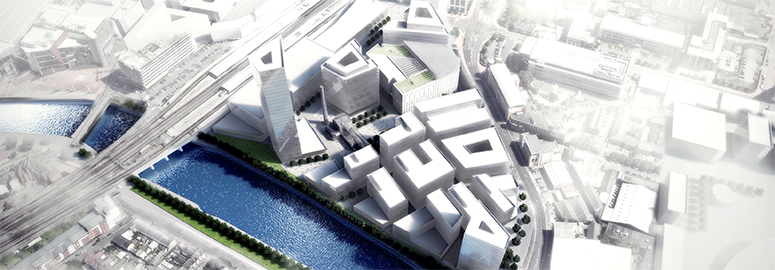When Cardiff-based auto insurance business MotoNovo announced it was to leave its out-of-town offices to take space in the city centre, was the market surprised? Was this a one-off or a sign of a changing demands driving occupiers decisions?
MotoNovo is leaving its offices at Llanishen to take 135,000 sq ft of new space at One Central Square and it is certainly seen as a shift in gear for the Cardiff office market – and a sign that it has reached a new level.
From now on, say enthusiasts, the city centre will remorselessly suck business from the out-of-town markets. An agglomeration effect – similar to that which has grown Bristol, Birmingham and Manchester city centres – is about to get under way.
According to many of those involved in recent (and forthcoming) relocations, this shift is being driven by the human resources departments of the larger occupiers. In short, the battle for talented staff has reached Cardiff – and the battlefield is going to be the city centre.
Meanwhile, the public sector is also spotting an opportunity to upgrade premises and improve efficiency by moving to the city centre. The 20m-high dragon proposed for the top of the 270,000 sq ft HMRC office at Rightacres’ Central Square could be a symbol of the consolidation of Welsh office jobs in the heart of the capital. Like MotoNovo, they too are leaving Llanishen.
Speaking after the deal was announced, MotoNovo chief executive Mark Standish confirmed that recruitment was at the root of the company’s decisions. “We continually strive to create a culture in which people move up, not on, so being able to provide the team with offices they can be proud of is hugely significant,” he said, adding: “With this move complete, we are ready to concentrate on the next phase of our growth plans, and set about the task of increasing our workforce to the benefit of the Welsh economy as a whole.”
Ben Bolton, director at Cooke & Arkwright and an adviser to the firm, explains the motivation. He says the human resources angle was not – at first – the motive for the MotoNovo move, but that it quickly became dominant.
“The original problem had been overcrowding – they had 20,000 sq ft, and ratios were falling to 1:80 sq ft, which would be OK in a contact centre, but not in MotoNovo’s context,” Bolton explains.
Source: Knight Frank
Relocation considerations
The first thought was to take a new office nearby – and keep the existing Cardiff business park floorspace – or to take a new larger out-of-town office. But as the business continued to grow, that option began to seem less appealing.
“We challenged MotoNovo to consider what the real driving force for change was – and at that point new issues arise. Issues like what bus route Doris from accounts might use changes as you look at staff projections and growth forecasts, and when a business reaches a certain size you hit a tipping point,” says Bolton.
Suddenly recruitment and retention of staff became the big issues. “And that made the city centre an option,” Bolton recalls.
“The stark reality is that if you have over about 150 staff you’ve crossed the tipping point when the city centre becomes more attractive. You have a better chance to recruit, and although I couldn’t give you evidence, probably access to a younger workforce. And issues like car parking begin to be less easy to satisfy even out-of-town, so one of the advantages of business parks diminish.”
The 12-month search ended happily and, according to many, battle-for-talent concerns are behind other moves now being considered.
The stark reality is that if you have over about 150 staff you’ve crossed the tipping point when the city centre becomes more attractive. You have a better chance to recruit, and although I couldn’t give you evidence, probably access to a younger workforce.”
Matt Phillips, managing partner at Knight Frank, says: “The growth of the Cardiff office market is all about amenities and recruitment. It’s no longer the finance director that drives the relocation process, but the human resources director. They want to be in the right place to recruit the bright young things – so a good gym nearby, a nice sandwich shop.”
“At the same time as the war for talent is driving the choice of location, it is driving the fit-out. We used to think in terms of £30-£40 per sq ft to fit out a good city centre office. Today it’s said that the MotoNovo fit out is more like £120-£130 per sq ft, which just shows you how things have changed.”
The MotoNovo fit-out costs are widely talked about but are unconfirmed. It does, however, illustrate how the dialogue around office requirements is changing.
Developers can see the way the wind is blowing. Rightacres is understood to be pushing on aggressively with plans for the Brains brewery site south of Cardiff Central station. A planning application for a 2.5m sq ft mixed-use scheme is likely before the end of the year.
Rightacres chief executive Paul McCarthy says: “There’s no doubt that the availability of public transport is top of the list when large employers are considering relocating their business and this is reflective in the success of Central Square as a business location.”
“Our development to the south of the station, Central Quay, offers all the same transport advantages together with a waterfront leisure destination featuring high-quality bars and restaurants.”
“There will always be an out-of-town offer, but I believe that to recruit the best staff the employer needs to offer the best accommodation, with amenities and public transport close to hand. Central Square and Central Quay offer just that.”

Pull and push of city locations
Those with their shirt in the game agree. Tom Roberts, senior manager at LGIM Real Assets, who are backing Rightacres, says high-quality new developments are inevitably pulling in occupiers new to the city centre.
“There is no real surprise that occupiers are looking to base themselves here, which has resulted in tenants relocating from elsewhere in the city centre as well as from the wider surrounding area,” he says.
Roberts says the “pull” of new top-grade floorspace is combined with a “push” nudging occupiers out of alternative locations.
There will always be an out-of-town offer, but I believe that to recruit the best staff the employer needs to offer the best accommodation, with amenities and public transport close to hand.”
The push-factor is the difficulty of funding decent floorspace anywhere other than the city centre.
“In order to see a demonstrable change in this trend, either rents would need to grow outside of core city centre markets or build costs would need to reduce to support a return to economically viable development off lower rents – I’m afraid to say that I think neither is highly likely in the short-term,” he says.
Is Cardiff’s office market in the midst of a long-term re-adjustment, away from places like Llanishen and into the city centre? Or is this a blip – like the blip of 2011 – that temporarily diverts demand into the central core, only to see it drift back to the business parks when pricing becomes more important to occupiers than it is today?
Nobody in Cardiff knows. But for now, the city centre is enjoying its moment in the July sun.
Public sector sees the appeal
It is not just the private sector feeling the appeal of the city centre. HMRC is on the brink of taking 270,000 sq ft at Central Square, while Public Health Wales leads a growing list of quangos also on the move or consolidating their city centre presence. Transport for Wales is, however, tipped for a location further west – perhaps Pontypridd.
Some say relocating to the city centre appeals to the civil-service mind: it is familiar territory and involves less risk, financially and otherwise.
JLL’s Cardiff boss Chris Sutton chairs the advisory board for the city’s enterprise zone. He says the sheer volume of city centre development – and the dearth of schemes in the out-of-town market – tips the balance.
“We’re definitely seeing agglomeration into Cardiff in the public sector. And Cardiff is doing well because it has the office space, and it is after all the capital city,” he says.
Take-up balance tips
The shift in demand from out-of-town to city centre is already well under way, according to figures from Knight Frank.
Pick any year before 2015 and the market divides fairly evenly: roughly half of take-up goes to the city centre, roughly half to the business parks.
However, from 2015 a new trend emerges, with the city centre claiming more than two-thirds of the take-up. In 2016 the city centre claimed 70% of the 685,000 sq ft let.
Matt Phillips, managing partner at Knight Frank, says: “You began to get a sense of the shift five years ago, when Cardiff Bay (above) began to falter – and we saw a big rise in city centre take-up in 2011. But for the last two years the trend has been strongly towards the city centre, and most of the bigger enquiries are now focused there.”
Rhys James, head of Cushman & Wakefield’s Cardiff office, says: “Business parks at the Cardiff M4 junctions – junction 28, junction 32 – haven’t seen new development for years, and that has coincided with a burst of speculative development in the city centre.”
However, James warns the loss of secondary office space to other uses – predominantly student housing – is leaving the city centre market exposed. The lack of refurbishment opportunities means rents on Grade B office space are rising, up from £12-£13 per sq ft to £17-£18 per sq ft.
The slow train…
Good transport will help Cardiff to out-pace the out-of-town office market, say agents, but they warn that action is needed quickly to improve Cardiff Central station.
“We get a new Welsh train franchise next year – that will be significant – and getting the Cardiff metro going is high on the radar, but what we also need is Network Rail coming up with realistic development plans for Cardiff Central station, because it is in very dire need,” says Rhys James, head of Cushman & Wakefield’s Cardiff office.
The problem gets worse by the day. The station is forecast to see 22m passengers within five years, up from 13m only four years ago. A £5m feasibility study is soon to begin – fingers crossed.
Network Rail say they are on the job already. In January a new platform (8) opened along with a new waiting area, the latest phase of a £300m plan to improve signalling and modernise the local network.
The new platform will immediately ease congestion and gives the potential for more services to run in the Cardiff area.











